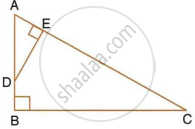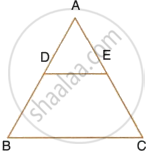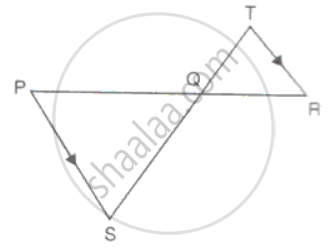Advertisements
Advertisements
प्रश्न
ABC is a right angled triangle with ∠ABC = 90°. D is any point on AB and DE is perpendicular to AC. Prove that :

- ΔADE ∼ ΔACB.
- If AC = 13 cm, BC = 5 cm and AE = 4 cm. Find DE and AD.
- Find, area of ΔADE : area of quadrilateral BCED.
उत्तर
i. Consider ΔADE and ΔACB
∠A = ∠A ...[Common]
m∠A = m∠E = 90°
Thus, by Angle-Angle similarity, triangles ΔACB ∼ ΔADE
ii. Since ΔADE ∼ ΔACB, their sides are proportional
`=> (AE)/(AB) = (AD)/(AC) = (DE)/(BC)` ...(1)
In ΔABC, by Pythagoras Theorem, we have
AB2 + BC2 = AC2
`=>` AB2 + 52 = 132
`=>` AB = 12 cm
From equation 1 we have
`4/12 = (AD)/13 = (DE)/5`
`=> 1/3 = (AD)/13`
`=> AD = 13/3 cm`
Also, `4/12 = (DE)/5`
`=> DE = 20/12 = 5/3 cm`
iii. We need to find the area of ΔADE and quadrilateral BCED
Area of ΔADE = `1/2 xx AE xx DE`
= `1/2 xx 4 xx 5/3`
= `10/3 cm^3`
Area of quadrilateral BCED = Area of ΔABC – Area of ΔADE
= `1/2 xx BC xx AB - 10/3`
= `1/2 xx 5 xx 12 - 10/3`
= `30 - 10/3`
= `80/3 cm^2`
Thus, ratio of areas of ADE to quadrilateral BCED = `(10/3)/(80/3) = 1/8`

APPEARS IN
संबंधित प्रश्न
On a map, drawn to a scale of 1 : 250000, a triangular plot PQR of land has the following measurements :
PQ = 3cm, QR = 4 cm and angles PQR = 90°
(i) the actual lengths of QR and PR in kilometer.
(ii) the actual area of the plot in sq . km.
In the given figure, ∠1 = ∠2 and `(AC)/(BD)=(CB)/(CE)` Prove that Δ ACB ~ Δ DCE.
State the SAS-similarity criterion
In the given figure, ΔABC ~ ΔADE. If AE : EC = 4 : 7 and DE = 6.6 cm, find BC. If 'x' be the length of the perpendicular from A to DE, find the length of perpendicular from A to BC in terms of 'x'.

Find the area of the triangle ABC with the coordinates of A as (1, −4) and the coordinates of the mid-points of sides AB and AC respectively are (2, −1) and (0, −1).
In the figure, PQR is a straight line and PS || RT. If QS = 12cm, QR = 15cm, QT = 10cm and RT = 6cm, find PQ and PS.
In ΔABC, AB = 8cm, AC = 10cm and ∠B = 90°. P and Q are the points on the sides AB and AC respectively such that PQ = 3cm ad ∠PQA = 90. Find: The area of ΔAQP.
ΔXYZ is enlarged to ΔX'Y'Z'. If XY = 12cm, YZ = 8cm and XZ = 14cm and the smallest side of ΔX'Y'Z' is 12cm, find the scale factor and use it to find the length of the other sides of the image ΔX'Y'Z'.
A map is drawn to scale of 1:20000. Find: The distance covered by 6cm on the map
Is the following statement true? Why? “Two quadrilaterals are similar, if their corresponding angles are equal”.
